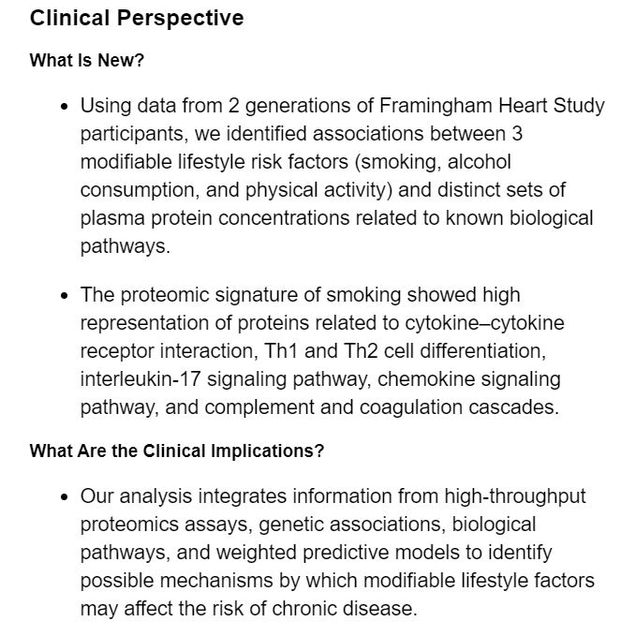Recent Findings: January 12, 2021
Smoking, alcohol, and physical activity are associated with protein signatures – new findings from the Framingham Heart Study
Academic Abstract:
Background
Proteomic biomarkers related to cardiovascular disease risk factors may offer insights into the pathogenesis of cardiovascular disease. We investigated whether modifiable lifestyle risk factors for cardiovascular disease are associated with distinctive proteomic signatures.
Methods and Results
We analyzed 1305 circulating plasma proteomic biomarkers (assayed using the SomaLogic platform) in 897 FHS (Framingham Heart Study) Generation 3 participants (mean age 46±8 years; 56% women; discovery sample) and 1121 FOS (Framingham Offspring Study) participants (mean age 52 years; 54% women; validation sample). Participants were free of hypertension, diabetes mellitus, and clinical cardiovascular disease. We used linear mixed effects models (adjusting for age, sex, body mass index, and family structure) to relate levels of each inverse‐log transformed protein to 3 lifestyle factors (ie, smoking, alcohol consumption, and physical activity). A Bonferroni‐adjusted P value indicated statistical significance (based on number of proteins and traits tested, P<4.2×10−6 in the discovery sample; P<6.85×10−4 in the validation sample). We observed statistically significant associations of 60 proteins with smoking (37/40 top proteins validated in FOS), 30 proteins with alcohol consumption (23/30 proteins validated), and 5 proteins with physical activity (2/3 proteins associated with the physical activity index validated). We assessed the associations of protein concentrations with previously identified genetic variants (protein quantitative trait loci) linked to lifestyle‐related disease traits in the genome‐wide‐association study catalogue. The protein quantitative trait loci were associated with coronary artery disease, inflammation, and age‐related mortality.
Conclusions
Our cross‐sectional study from a community‐based sample elucidated distinctive sets of proteins associated with 3 key lifestyle factors.
Read article full text online:
